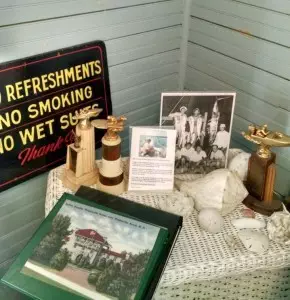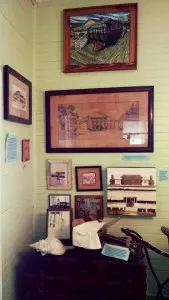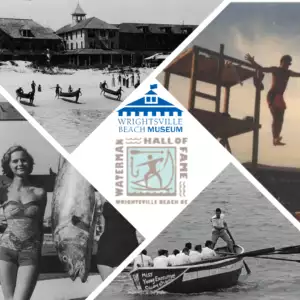Exhibits and Virtual Tour
The Wrightsville Beach Museum is currently in the 1909 Myers Cottage where it reflects how life was lived in a typical summer cottage at Wrightsville Beach. We have a bedroom, bathroom and kitchen showing typical furnishings of the time. Other rooms feature exhibits showcasing various periods of history, events, or items that reflect a lifestyle of times past. Visitors can view slideshows of photographs and postcards in our collection and an oral history video, where longtime residents reminisce about Wrightsville Beach and Lumina pavilion of the 1940s.
Here are some of our current exhibits.
The Hurricane Pole
One of our most popular exhibits is what has become known as the Hurricane Pole. This unique outdoor exhibit is the brainchild and handiwork of Dylan Rosbrugh as his Eagle Scout project. We are so delighted that he chose the museum as the recipient. Storm surge levels, winds, Coastal Warning Display Signal Flags, Saffir-Simpson Hurricane Wind Scale…you will learn about all of these! It’s an outdoor exhibit so you can drop by to see it 24/7. Loop Walkers, come by and take a look!
Captain Eddy Haneman
We have been donated the compass of Captain Eddy Haneman from his boat, the Martha-Ellen, a Marlin Spike Sword Capt. Eddie gave to a friend who often fished with him, and new personal photographs of the catches from fishing trips with Captain Eddy. Come by and see these treasures.

RACING AND BOATING TROPHIES
The Mailbox is currently at the museum!
Now on display at the museum is The Mailbox that was formerly at the north end of the beach. For 11 years this mailbox sat in a secluded spot at the north end of Wrightsville Beach accessible by a short walk into the dunes. A local couple kept the mailbox supplied with notebooks for visitors notes, rotating out the filled notebooks and replacing them with blank ones and a steady supply of pens and pencils. 125 Notebooks have been given to the museum along with the last mailbox. We are making a few notebooks available each month for visitors to look at. Just in: Notecards of the mailbox by a local photographer.

WOOL BATHING SUITS HANGING TO DRY AND A LETTER ABOUT THE BATHING SUIT INSPECTOR. YES, THERE WAS REALLY SOMEONE WHO DETERMINED IF YOU BATHING SUIT WAS TOO RISQUE TO BE WORN AT WRIGHTSVILLE BEACH !
The History of the Bathing Suit: a timeline showcasing how swimsuit fashion has changed.
Wrightsville Beach Museum of History’s new exhibit is on the history of the bathing suit with a timeline showing how the design and materials changed over the years and why. Did women really have to wear stocking and swim “booties” in the early 1900s? Did men have to wear bathing shirts? Those unattractive black bathing suits you could rent at Lumina in the 1920s – what material were they made of? We have lots of answers to your questions and fun photographs. We even have on our front porch a life-sized cut-out of a man and woman in bathing costumes with space for you to put your face through and have your photo taken as a 1920s bathing beauty!
See inside the museum: our virtual tour
Beachfront Model
Couples dance at Lumina to the music of Benny Goodman. A young lady emerges from the bathhouse sporting her new bathing suit. The trolley stops, dropping off its first passenger of the day to Wrightsville Beach.



These images, along with the sun, sand, and ocean, come to life in the museum’s centerpiece–a twelve foot model of Wrightsville Beach as it looked circa 1910, about the time that the museum house, the Myers Cottage, was built. Displayed are replications of Lumina, Brown’s Bathhouse, a working trolley car, Station One, Little Chapel on the Boardwalk, The grand Oceanic and Seashore hotels and the museum cottage in its original location. The construction of this model is due to the skill and craftsmanship of Maricam Kaleel of Model Makers and Bill Creasy. Working form photographs, many of which were over 100 years old, they made the original model piece by piece, inch by inch. More recent additions were done by Jon Michael and Ted O’Quinn. The new model cover, completed in 2015, was made by Matt Winkle.
The Trolley Exhibit
This display contains pictures and artifacts pertaining to the trolley that once ran from downtown Wilmington out to Wrightsville Beach, just 10 miles away. in its heyday, a trolley would arrive at the beach as often as every 30 minutes, bringing hundreds of visitors as well as vendors supplying the island with ice, milk, vegetables and all types of needed items since there was no market at Wrightsville Beach.
    |
The Kitchen
In the early twentieth century American kitchens, the dominant color was white. Walls were frequently covered with white ceramic tile or painted with white enamel paint, as was the furniture and all the woodwork. The ideal kitchen sink was porcelain enameled on cast iron, also in white. For cooking, the convenience and cleanliness of electric stoves took preference in households, as in this kitchen. Displayed here are pieces of china from the Oceanic Hotel, which burned down in the Great Fire of 1934, samples of previous linoleum flooring, and a variety of kitchen equipment you may recognize. The Porch Dining was frequently enjoyed outdoors on the porch to take advantage of the cool summer breezes at Wrightsville Beach. The porch was also the place where the icebox was kept, for easy disposal of the melted ice. Here, perishables such as butter, milk, and meats were stored. The icebox was introduced in the 1860s, and in thirty years became a household necessity. It remained the primary food storage appliance until the introduction of the monitor-top refrigerator in 1927. Iceboxes were available in various sizes, ranging from a twenty-five pound to a hundred pound ice block capacity. The trolley brought routine deliveries of ice from Wilmington to the inhabitants of Wrightsville Beach to keep the icebox cool in the blistering summer heat. In a turn of the century beach cottage bedroom, the theme was simplicity. Pictured here is the jailhouse bed retrieved from the servant’s quarters at the house’s original location. In this room we have a shell cabinet full of shells from far and wide, a dresser originally in a room at the Glenn, Wrightsville Beach Little League and Little Chapel on the Boardwalk basketball uniforms, and a selecton of dresses from the 1920s-1940s, including a silk velvet and beaded dress worn dancing at Lumina in the 1920s. The Bathroom During the early decades of the nineteenth century, bathing was not a regular practice. Indoor plumbing did begin to emerge in the 1830s but usually only in the homes of the wealthy. Bathrooms only became a commonplace feature in the urban American home after the Civil War due to the rise of industrialization, reliable water systems and new ideas on sanitation and cleanliness. By the 1890s, the American bathroom had developed the general equipment and arrangement that characterize today’s bathroom. Standard fixtures included a bath or shower, a toilet, and a wash basin. Designs were kept simple, for the stress was on the utilitarian function of the bathroom. By the early 1900s white fixtures in the bathroom were the trend just as it was in the kitchen. Pictured here are typical fixtures of early twentieth century bathrooms–the free standing, single pedestal sink, a high-tank toilet, and claw-footed tub. Don’t miss the Bathing Suit exhibit on the walls! And the letters concerning the Bathing Suit Inspector! |










